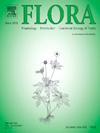Epifagus virginiana(大戟科)块茎适应墨西哥山毛榉微环境的功能特征
IF 1.7
4区 生物学
Q3 ECOLOGY
引用次数: 0
摘要
Epifagus virginiana(大戟科),又名榉树绒毛虫,是一种全寄生植物,只能从少数寄主植物中获取所有资源,仅限于北美的法桐物种。为此,榉树滴叶草通过末端的菌丝体与寄主建立维管联系,该菌丝体发育成块茎,附着在寄主根部。我们假设,尽管这种寄生虫的营养完全依赖于寄主植物,但微环境条件会影响 E. virginiana 块茎的功能特征。因此,本研究的目的是 i) 分析 E. virginiana 块茎的结构;ii) 评估两个 E. virginiana 种群之间块茎功能特征的差异;iii) 分析微环境因素如何影响块茎的功能特征。我们发现,墨西哥山毛榉块茎的功能性状与墨西哥山毛榉微环境中对地下过程很重要的性状有关。增强回归树提供了一个强大的分析工具,其预测性能大大优于广义加性模型,尽管后者拟合了交互项。本文章由计算机程序翻译,如有差异,请以英文原文为准。
Functional traits of Epifagus virginiana (Orobanchaceae) tubers as adaptations to the Mexican beech microenvironment
Epifagus virginiana (Orobanchaceae), known as beechdrops, is a holoparasitic plant that acquires all its resources from a narrow range of host plants, restricted to North American Fagus species. To do so, beechdrops develop a vascular connection with the host via a terminal haustoria that develops as a tuber attached to the host root. We hypothesized that microenvironmental conditions can influence functional traits of the E. virginiana tuber despite this parasite's complete reliance on the host plant for its nutrition. Therefore, the aims of this study were i) to analyze the structure of the tubers of E. virginiana; ii) to assess the variation in tuber functional traits between two E. virginiana populations; and iii) to analyze how microenvironmental factors influence functional traits in the tuber. We detected that functional trait of beechdrops tuber along Mexican beech microenvironmental covaried with traits important for below-ground processes. Boosted regression trees provided a powerful analysis tool, giving substantially superior predictive performance to generalized additive models, despite the fitting of interaction terms in the latter.
求助全文
通过发布文献求助,成功后即可免费获取论文全文。
去求助
来源期刊

Flora
生物-植物科学
CiteScore
3.30
自引率
10.50%
发文量
130
审稿时长
54 days
期刊介绍:
FLORA publishes original contributions and review articles on plant structure (morphology and anatomy), plant distribution (incl. phylogeography) and plant functional ecology (ecophysiology, population ecology and population genetics, organismic interactions, community ecology, ecosystem ecology). Manuscripts (both original and review articles) on a single topic can be compiled in Special Issues, for which suggestions are welcome.
FLORA, the scientific botanical journal with the longest uninterrupted publication sequence (since 1818), considers manuscripts in the above areas which appeal a broad scientific and international readership. Manuscripts focused on floristics and vegetation science will only be considered if they exceed the pure descriptive approach and have relevance for interpreting plant morphology, distribution or ecology. Manuscripts whose content is restricted to purely systematic and nomenclature matters, to geobotanical aspects of only local interest, to pure applications in agri-, horti- or silviculture and pharmacology, and experimental studies dealing exclusively with investigations at the cellular and subcellular level will not be accepted. Manuscripts dealing with comparative and evolutionary aspects of morphology, anatomy and development are welcome.
 求助内容:
求助内容: 应助结果提醒方式:
应助结果提醒方式:


